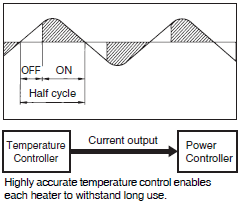Power Controllers
MRON provides single-phase/three-phase Power Controllers with a phase control system and Multi-channel Power Controller that enable high-precision temperature control with optimum cycle control.
| Introduction | Features |
| Principles | Classifications |
| Engineering Data |
|
|
|
Troubleshooting |
-
 What Is a Power Controller?
What Is a Power Controller?
-
 Configurations and Types of Heater Control
Configurations and Types of Heater Control
-
 G3PW Control Methods and Combination Examples
G3PW Control Methods and Combination Examples
-
 Connection Examples of G3PW and Temperature Controller
Connection Examples of G3PW and Temperature Controller
What Is a Power Controller?
A Power Controller continuously adjusts the power consumed by a heater with phase control or optimum cycle control mainly by receiving an analog signal, such as a 4 to 20 mA signal from a temperature controller, or by receiving manual settings made with a variable resistor.

Configurations and Types of Heater Control
Power controllers are mainly used for heater control.
Each heater control method has its own features, so it is necessary to decide the method that matches your application.

Heater Control Methods
(1) ON/OFF Control

(1) ON/OFF time-sharing proportional control is the most widely used control method in combination with temperature controllers.
(2) The large difference in temperature of the heater, when turning ON and OFF will shorten the service life.
(3) This method is suitable for controlling items with a large heat capacity, which are difficult to heat and cool.
(2) Phase Control

(1) The output value is changed each half cycle, enabling highaccuracy temperature control.
(2) More finely tuned control enables resistance to external disturbances and few heat shocks, thereby extending the service life of the heater.
(3) The gradient can be set as desired, and so the output value can be set when a Power Controller is used in a set with a temperature controller.
(4) Inrush current can be suppressed by using a soft start or a constant-current circuit.
(5) Noise occurs due to phase control.
(3) Optimum Cycle Control (High-accuracy zerocross control)

(1) The output cycle of the voltage output enables detailed control with a short cycle, which achieves temperature control with greater precision than ON/OFF time-sharing proportional control.
(2) Manual control without the use of temperature controllers has been achieved. (An external variable resistor is used.)
(4) Cycle Control

(1) The output cycle of the voltage output enables detailed control with a short cycle, which achieves temperature control with greater precision than ON/OFF time-sharing proportional control.
(2) Manual control without the use of temperature controllers has been achieved. (An external variable resistor is used.)
For information on Multi-channel Power Controllers and Cycle Control Units, refer to the product datasheets.
G3PW Control Methods and Combination Examples
The G3PW is a thyristor-type single-phase power controller that enables precise temperature control.
It is combined with a temperature controller or other device to control a heater.
What Is G3PW Analog Control?
The change in current output of the temperature controllers between 4 and 20 mA is used for precise heater control by the G3PW, which outputs smoothly adjusted power. Fine adjustments of the heater temperature are possible with external or internal duty setting.
What Is G3PW ON/OFF Control?
The voltage output of the temperature controllers is used for ON/OFF heater control. Fine adjustments of the heater temperature are possible with external or internal duty setting.
What Is G3PW Manual Control?
Output adjustments are possible with an external variable resistor.

Connection Examples of G3PW and Temperature Controller
If a single temperature controllers is in control of more than one heater, by making a proper duty setting, the difference in temperature between the heaters can be improved.
Note: The temperature at point B can be higher than that at point A due to thermal interference. In that case, make the duty set value for heater B smaller than that for heater A so that there will be no difference in temperature between points A and B.
